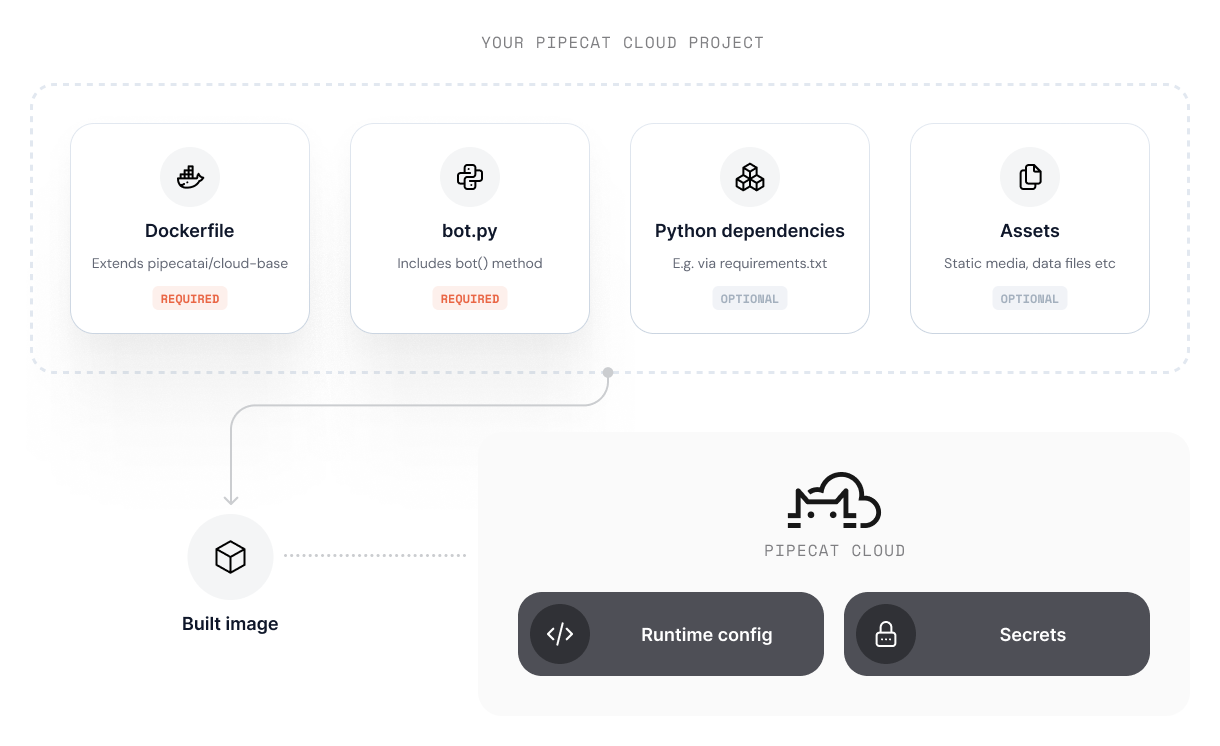- Dockerfile using uv
- Dockerfile using pip

Using an official base image
Pipecat Cloud provides a series of base images that we recommend for most use-cases. Base images provide:- Simplified development and deployment
- Optimizations for performance and security
- Pre-installed system dependencies for most multi-modal agent use-cases
- Your project must contain a
bot.pyfile that defines the agent pipeline - The
bot.pymust contain abot()method that is the entry point for your agent pipeline - The
bot()method must be asynchronous, e.g.async def bot():
CMD as part of your Dockerfile - the base image is configured to run your bot.py module.
You can browse available base images in the Pipecat Cloud Docker Hub .
If you wish to print a summary of the features available in the base image, set the environment variable PCC_LOG_FEATURES_SUMMARY to true.
This will print all the features enabled in the base image that you can use. For example:
Available images
Base Image
| Name | Description |
|---|---|
dailyco/pipecat-base | Multi-modal Pipecat optimized, suitable for most use-case |
dailyco/pipecat-base:latest(Python 3.12, default)dailyco/pipecat-base:latest-py3.10(Python 3.10)dailyco/pipecat-base:latest-py3.11(Python 3.11)dailyco/pipecat-base:latest-py3.12(Python 3.12)dailyco/pipecat-base:latest-py3.13(Python 3.13)
dailyco/pipecat-base:0.1.0(Python 3.12, default)dailyco/pipecat-base:0.1.0-py3.10(Python 3.10)dailyco/pipecat-base:0.1.0-py3.11(Python 3.11)dailyco/pipecat-base:0.1.0-py3.12(Python 3.12)dailyco/pipecat-base:0.1.0-py3.13(Python 3.13)
For production use, we recommend pinning to specific versions.
Starter Images
Pipecat starter images are deprecated and will be removed after October
15, 2025. Use
pipecat-quickstart or
pipecat-examples instead as
a starting point.
Using a custom image
For more complex use-cases, you can use a custom image. When doing so, we recommend following best practices to ensure your agent instance runs optimally on the platform. Our base image is open source and serves as a useful blueprint for configuring your custom agent image.Agent image structure
Custom agent images are for advanced use cases. For most teams,
we recommend using our base images. If needed, consult the base
image code as a reference.For unsupported use cases, contact us at help@daily.co or via
Discord.
- HTTP API that can handle requests from the platform to configure and run agent instances.
- The necessary system level dependencies (such as Python.)
POST /bot route that will be called by the platform.
We recommend using FastAPI to create this route. Please refer to the base image code for an example of how to do this.
Building the image
While in beta, Pipecat Cloud requires all images to be built to target Linux on ARM. This is the most common platform for cloud deployments.- All dependencies required for your agent to run.
- Assets (such as images or models) available in the container filesystem
- The entry point for your agent (usually a Python script)
- Additional system dependencies (if required)
Best practices
- Keep your image as small as possible. Use multi-stage builds to reduce the size of the final image.
- Use a
.dockerignorefile to exclude unnecessary files from the image. - Pipecat Cloud will automatically restart your agent if it crashes. Ensure your agent can handle this gracefully.
- Use Secrets to securely store sensitive information in your agent image.
- To optimize for fast start-ups, avoid long running or blocking processes during initialization.